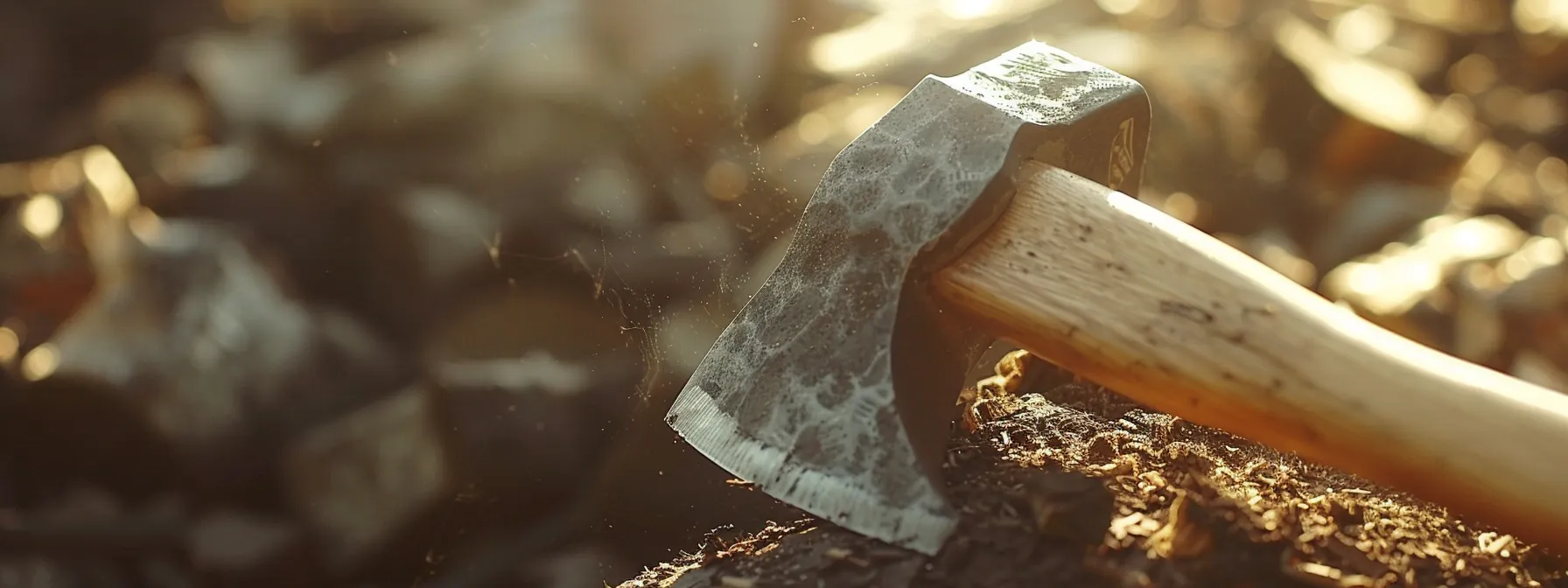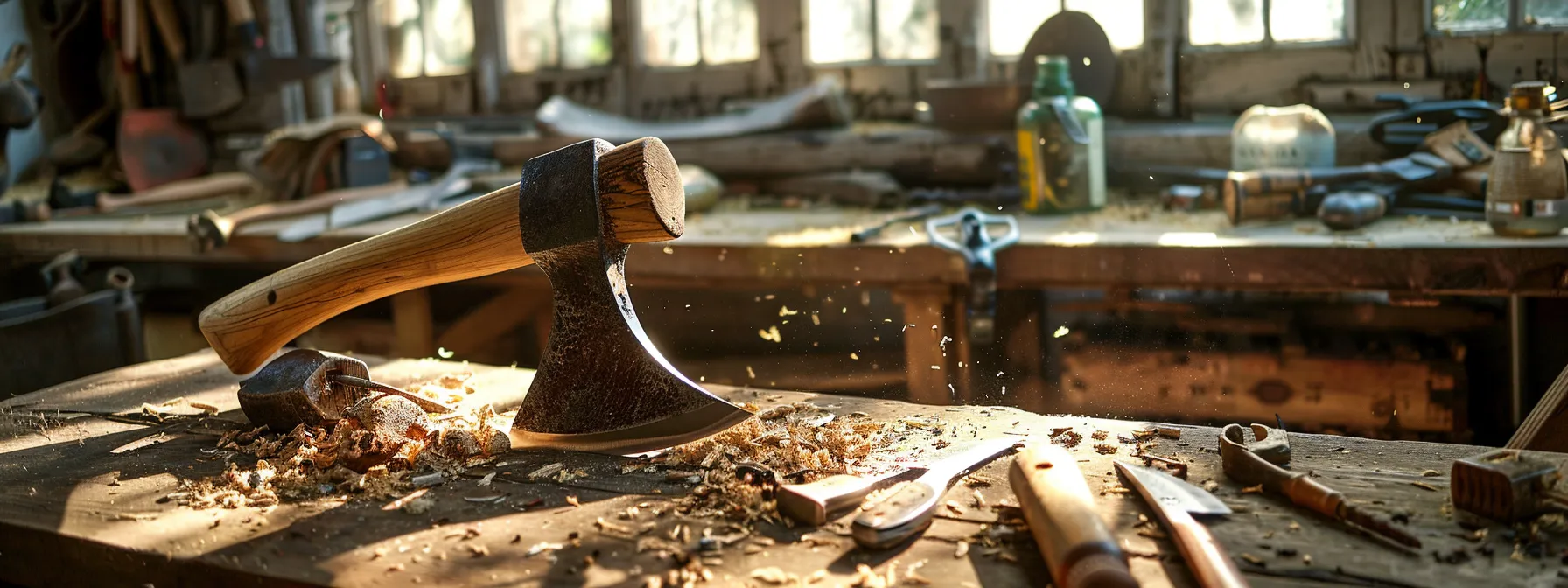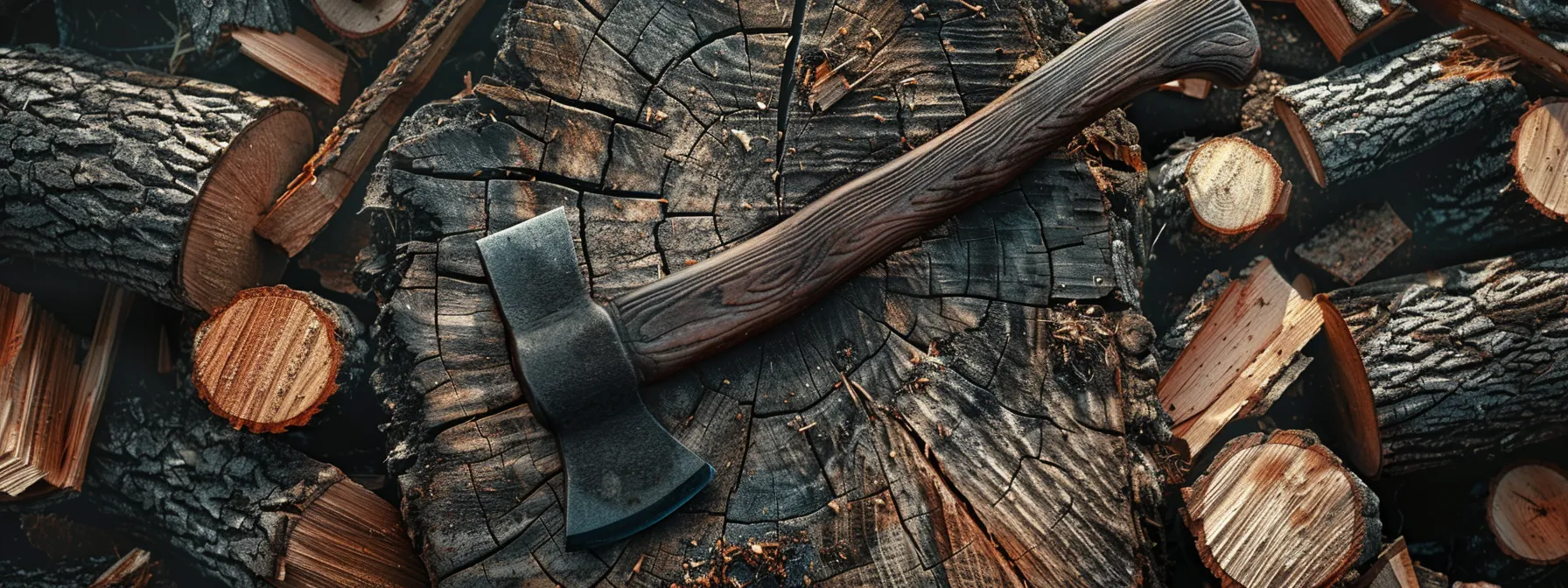Are you struggling to find the right axe for splitting firewood? Many outdoor enthusiasts and woodworkers face this challenge, often leading to inefficient and frustrating splitting sessions. In this guide, I will discuss the fundamentals of wood splitting axes, highlight key features to look for, and review top-rated options that include durable carbon or fiberglass handles. By understanding these aspects, you'll be better equipped to select an axe that meets your needs, making the task of processing grain-based firewood more efficient and enjoyable. Let's get started on finding the best axe for your wood splitting adventures.
Key Takeaways
- selecting the right axe enhances efficiency in wood splitting tasks
- a splitting axe differs significantly from standard axes, with a wider head for better performance
- using proper maintenance techniques extends the lifespan of your wood splitting axe
- safety gear is essential when performing wood splitting to prevent injuries
- understanding axe weight and design influences effective wood splitting for different wood types
Understanding the Fundamentals of Wood Splitting Axes

axes play a crucial role in efficient wood splitting, providing the power needed to break down logs. Understanding the differences between a good wood splitting axe and other axes ensures you choose the right tool for your needs. In the following sections, we'll cover the essential features, like hickory handles and their advantages, and how to select a reliable axe that meets your expectations, including considerations like warranty and durability.
The Role of Axes in Efficient Wood Splitting
Axes are essential tools for efficient wood splitting, acting as the primary instrument for lumberjacks and outdoor enthusiasts alike. When I split wood, I rely on an axe designed specifically for the task, as it helps me exert maximum force downwards onto the log. Features like a metal head paired with a composite material handle provide the durability I need, while the proper weight—often around three to four pounds—ensures I can maintain control with just a glove on my hand.
- Importance of using the right axe for effective wood splitting
- Weight and balance considerations for optimal swing
- Materials used in axe construction for durability
- Personal experience with the right tools increases efficiency
Differences Between Splitting Axes and Other Axes
When comparing splitting axes to other axes, I find that the differences are essential for effective wood splitting. A splitting axe has a wider head and a sharper angle than a traditional felling axe, which makes it ideal for breaking apart wood fibers rather than simply cutting through them. For outdoor enthusiasts, choosing the best ax for chopping down a tree can be tempting, but knowing that a dedicated splitting axe is more effective for managing the firewood you'll need for camping or bushcraft activities helps ensure you make the right investment.
Selecting the Right Axe for Your Needs
Selecting the right axe is crucial for anyone serious about wood splitting. I always recommend looking for features that enhance usability, such as a comfortable hand grip made from leather, which can prevent slipping and improve control during use. Additionally, consider the best wood splitting maul with a corrosion-resistant head, which will ensure lasting performance even in challenging environments. Understanding your specific needs, whether for hunting or general outdoor use, allows you to choose an axe that not only fits your hand comfortably but also withstands the test of time.
Now that we grasp the basics of wood splitting axes, it's time to look at what makes the best ones stand out. These key features will help you choose the right tools for your needs.
Key Features of the Best Wood Splitting Axes

When searching for the best axes for wood splitting, prioritizing the axe head design is crucial as it directly impacts cutting performance. Additionally, understanding the importance of handle material and length can enhance your grip and control. The weight balance of the axe, combined with user comfort, affects how efficiently you can work with the best log splitting maul or best wood maul. In the following sections, I’ll delve deeper into these key features to help you choose the best ax for wood splitting that meets your needs, including insights on carbon steel options for improved durability.
Axe Head Design and Its Impact on Performance
The design of the axe head significantly influences its performance in woodworking, especially when splitting hardwood like oak. I’ve found that a wedge-shaped head is particularly effective, as it allows the axe to easily penetrate the wood fibers and separate them efficiently. A well-constructed axe head ensures better control and power, which translates into less effort and time spent on splitting logs.
- Wedge-shaped design for efficient penetration
- Importance of head construction materials
- Impact of head weight on swing and control
- Choosing the right size for your specific wood type
Importance of Handle Material and Length
The handle material and length of the best log splitting axe are vital for maximizing efficiency and comfort during use. I prefer handles made from durable materials like hickory or fiberglass, as they provide a good balance of flexibility and strength. The length of the handle can significantly affect the weight distribution and swing leverage; a longer handle allows for greater force with each swing, making it easier to split logs with larger diameters. By focusing on these features, I can ensure my axe performs effectively, whether I’m splitting wood for a cozy fire or prepping for a camping trip where a chainsaw isn't handy.
Weight Balance and User Comfort
Weight balance is critical when choosing a wood splitting axe, as it affects how comfortably you can swing it for extended periods. I’ve found that a good splitting maul should ideally weigh between three to six pounds; this weight allows me to apply sufficient force while still maintaining control. Brands like Cold Steel and Estwing offer models with a slight curve in the handle, enhancing ergonomics and reducing strain on my wrists during repetitive use, making wood splitting not just effective but also enjoyable.
With the right features in mind, finding the best wood splitting axe becomes a straightforward task. Let’s look at some of the top-rated axes that deliver the power and precision you need for your next project.
Top-Rated Axes for Wood Splitting

Top-Rated Axes for Wood Splitting
In this section, I’ll explore leading brands and models of axes, including options from Fiskars that are highly regarded for their quality. I’ll provide an in-depth analysis of each recommended axe, highlighting key features and performance. Additionally, I’ll discuss the pros and cons based on user reviews to help you identify the best splitting maul or good splitting maul for your wood splitting needs.
Overview of Leading Brands and Models
When searching for the best axe maul for splitting wood, I find several brands consistently stand out for their quality and performance. Fiskars, for example, offers lightweight models made from high-strength steel, allowing me to generate significant force with each swing while also ensuring durability. Another impressive choice is Estwing's splitting axe, known for its solid construction and optimal length, making it a reliable option for anyone looking for the best splitting axe. Each of these tools fits specific needs, whether for casual campfire prep or serious wood splitting tasks, ultimately elevating the splitting experience.
In-Depth Analysis of Each Recommended Axe
When it comes to selecting the best maul axe, I can confidently say that weight and design are crucial elements. For splitting larger logs, I have found that models like the Fiskars IsoCore Maul provide exceptional performance due to their innovative engineering, which reduces shock and vibration, enhancing comfort. Similarly, when I need a reliable tool for quick tasks like kindling, I prefer the best hatchet for kindling that combines a sharp blade with a lightweight nylon handle, ensuring quick and efficient splits without tiring my hands.
For those heavier jobs, I also recommend incorporating a dependable sledgehammer as part of your gear. Using a sledgehammer alongside a heavy maul can significantly increase your efficiency when splitting stubborn hardwood. I’ve personally experienced how this combination allows me to tackle tougher logs with ease, offering a practical solution for anyone looking to maximize their wood-splitting efforts.
Pros and Cons Based on User Reviews
Based on user reviews, I’ve noted several pros and cons when evaluating the best axes for wood splitting. Many users praise the balance and height of popular axes, which enhance control and accuracy during swings, making the wood splitting experience smoother and more efficient. However, some complaints often involve the weight distribution, with a few users finding certain models too heavy for extended use, which can lead to fatigue over time.
- Positive feedback on the balance and height enhancing control.
- Complaints about weight distribution affecting usability.
- Varied user experiences based on personal strength and preferences.
Having picked the best axes for splitting wood, the next step is to keep them sharp and ready. Proper maintenance will ensure your axe serves you well for years, making each swing effective and effortless.
Maintenance Tips for Your Wood Splitting Axe

Effective maintenance is essential for ensuring your wood splitting axe performs at its best. In this section, I’ll cover effective sharpening techniques to keep your blade sharp, tips on preventing rust and wear to extend its lifespan, and safe storage practices that protect your axe. Each of these areas is crucial for maintaining a reliable tool that meets your wood splitting needs.
Effective Sharpening Techniques
To ensure my wood splitting axe remains effective, I prioritize proper sharpening techniques. I use a hand file or a sharpening stone, focusing on maintaining the original angle of the blade to create a sharp edge that slices through wood effortlessly. Regularly honing the edge not only improves performance but also prolongs the life of the axe, making my wood splitting tasks more efficient and less labor-intensive.
Preventing Rust and Wear
To prevent rust and wear on my wood splitting axe, I consistently clean and dry the blade after each use. Moisture is the enemy of metal, so I apply a thin coat of oil to the blade and head; this simple step acts as a protective barrier against corrosion. Additionally, storing the axe in a dry, sheltered place is crucial to prolonging its lifespan and ensuring it’s always ready for action:
- Clean and dry the blade after use.
- Apply a thin coat of oil to the blade and head.
- Store the axe in a dry, sheltered location.
Safe Storage Practices
For safe storage of my wood splitting axe, I always ensure it is kept in a dry place to prevent rust and deterioration. I prefer to hang the axe on a pegboard or store it in a sheath to protect the blade from damage and accidental contact. This simple practice not only extends the lifespan of my axe but also keeps it ready for use whenever the need arises, ensuring efficiency in my wood splitting tasks.
Your axe is prepared, and it’s time to put it to work. But before you swing, let’s talk about safety practices that will keep you and those around you protected.
Safety Practices When Using Wood Splitting Axes

When using wood splitting axes, having the right safety practices in place is vital. I always emphasize the importance of wearing essential protective gear, such as gloves and safety glasses, to safeguard against injuries. It's equally important to adopt proper wood splitting techniques to maximize efficiency and minimize risk. Additionally, understanding common mistakes to avoid can significantly enhance your wood splitting experience and contribute to a safer environment.
Essential Protective Gear
When swinging a wood splitting axe, wearing the right protective gear is non-negotiable for preventing injuries. I always make sure to put on safety glasses to shield my eyes from flying wood chips, along with sturdy gloves that offer a good grip and protect my hands from splinters. Additionally, wearing steel-toed boots provides support and safeguards my feet from accidental drops, making my wood splitting tasks not only effective but also safe.
- Wear safety glasses to protect eyes from wood chips.
- Use sturdy gloves for a better grip and hand protection.
- Opt for steel-toed boots for foot protection.
Proper Wood Splitting Techniques
Proper wood splitting techniques are critical for both efficiency and safety. I always ensure my stance is firm, with my feet shoulder-width apart, allowing me to maintain balance while swinging the axe. Additionally, targeting the wood at a slight angle increases the chances of a clean split, and I ensure that I don't swing too close to my body to avoid accidental injuries. This straightforward approach not only enhances my wood splitting performance but also minimizes potential risks:
- Maintain a strong stance with feet shoulder-width apart.
- Target wood at a slight angle for improved splitting.
- Avoid swinging the axe too close to your body.
Common Mistakes to Avoid
One common mistake I see often with wood splitting is failing to inspect the axe before use. I always check the axe head for any cracks and ensure the handle is secure. Ignoring these details might lead to accidents or ineffective splits, which can turn an efficient task into a frustrating experience.
Another error is not choosing the right stance during the swing. I've noticed that many people swing with their feet too close together, which reduces balance and increases the risk of injuries. I make it a point to maintain a solid, shoulder-width stance to improve both control and safety while split logs.
Finally, I’ve observed that some individuals swing the axe too powerfully or too close to their bodies, leading to accidents. Focusing on swing control rather than raw power allows for more effective splits and minimizes risks. Practicing proper technique not only improves my efficiency but also keeps my wood splitting experience safe.
You’ve learned the safety rules for using wood splitting axes. Let’s address the most common questions that come up about these essential tools.
Frequently Asked Questions About Wood Splitting Axes

When selecting the best axes for wood splitting, it’s essential to understand the differences between an axe and a maul, as each serves a unique purpose. I’ll also highlight ideal axe sizes suitable for different wood types, making your choice easier. Additionally, if you’re new to wood splitting, I’ll provide practical tips to get you started safely and effectively.
How to Choose Between an Axe and a Maul
When deciding between an axe and a maul for wood splitting, I focus on the specific tasks I need to accomplish. An axe is typically better suited for felling trees or making precise cuts, while a maul excels at splitting larger logs due to its heavier, wedge-shaped head. For those times I've faced tougher hardwoods, a maul's design allows me to generate the necessary force to split with ease, making it a more effective tool for handling firewood preparation.
Ideal Axe Sizes for Different Wood Types
Choosing the right axe size for different wood types is crucial for effective splitting. For softer woods like pine, I often use a lighter, sharper axe around 2 to 3 pounds; it makes quick work of the softer fibers. However, when I'm tackling hardwoods like oak or hickory, I prefer a heavier maul of about 4 to 6 pounds, as its wedge shape allows me to generate more force, making the splitting process smoother and faster. Understanding these distinctions can significantly improve your wood-splitting efficiency:
- Lightweight axes (2-3 lbs) for softwoods like pine.
- Heavy mauls (4-6 lbs) for hardwoods like oak.
- Wedge-shaped heads enhance splitting efficiency.
Tips for Beginners in Wood Splitting
As a beginner in wood splitting, I recommend starting with the right axe for your skill level. Choose a lightweight axe or splitting maul that feels comfortable in your hands; this will help you develop proper technique without overwhelming yourself. Focus on practicing your stance and swing, aiming for accuracy rather than power to ensure safe and effective splits. Remember, gradual improvement in your skills will lead to a more enjoyable and efficient wood splitting experience.
Conclusion
Choosing the right axe for wood splitting is crucial for efficiency and safety. By understanding key features like axe head design, handle material, and weight balance, you can significantly enhance your splitting experience. Regular maintenance and proper technique further ensure your tool remains effective and enjoyable to use. Armed with this knowledge, you can confidently select the best axe to meet your wood-splitting needs, making every task more manageable and productive.













































Leave a comment (all fields required)